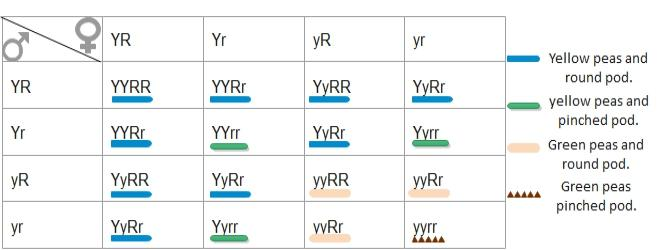
When a dihybrid cross is fit into a Punnett square with 16 boxes, the maximum number of different phenotypes available are-
A. 8
B. 4
C. 2
D. 16
Answer
511.5k+ views
Hint:A dihybrid cross is a mating event between two organisms that are each heterozygous for two separate genes, this dihybrid cross is performed in Punnett square with different genotype and phenotype alleles.
Complete answer:Let's take a look at classic Mendelian examples of pea plants. The first gene we look at is gene colour. Gene (1)- pea colour, this gene has two alleles a dominant allele (Y) that results in yellow pea colour and recessive allele (y) that results in green pea colour so, the homozygous dominant (YY) and the heterozygous genotype (Yy) results in green peas.
The second gene we look at shows pod shape and this gene also has two alleles. The dominant allele(R) results in a round pod shape so, the homozygous dominant (RR) and the heterozygous genotype (Rr) result in a round pod, and the homozygous recessive genotype (rr) results in a pinched pod of the plant.
In dihybrid's case, both parents have the genotype (YyRr) therefore, they will have yellow peas and round pods. Now we want to set up the Punnett square to look at the offspring of this cross. Remember that each row and column of Punnett square is headed by the different gametes produced by the parent. In this case, the parent genotype can result in four different gametes (YR, Yr, yR, yr).
Given the law of independent assortment, all of these gametes appear at equal frequency. Now, we know all our possible gametes will set up a Punnett square.

Fig (1) Dihybrid cross example in pea plants.
Each pair produces four different gametes. There will be four columns and four rows making 16 squares in this Punnett square and here is what we see, let's focus on a phenotype of the offspring all of these blue line squares represent offspring that have yellow peas and round pods, this phenotype occurs in 9/16 boxes. The yellow peas pinched pod of phenotypes occurs in 3/16 of the offspring, the green peas and round pod phenotype occur in 3/16 of the offspring and the green peas pinched pod phenotypes occurs in just one box making up 1/16 of the offspring. Hence, this distribution of four phenotypes is the classic mendelian 9:3:3:1 ratio for a dihybrid cross.
Hence, Option-B is the correct answer.
Note: Punnett square measures the probability of a genetic outcome. It is a tabular report with combinations of maternal alleles with paternal alleles. This is a visual representation of Mendelian inheritance. Using the Punnett square method, one should understand the terms of the heterozygous, homozygous, dominant allele, recessive allele etc.
Complete answer:Let's take a look at classic Mendelian examples of pea plants. The first gene we look at is gene colour. Gene (1)- pea colour, this gene has two alleles a dominant allele (Y) that results in yellow pea colour and recessive allele (y) that results in green pea colour so, the homozygous dominant (YY) and the heterozygous genotype (Yy) results in green peas.
The second gene we look at shows pod shape and this gene also has two alleles. The dominant allele(R) results in a round pod shape so, the homozygous dominant (RR) and the heterozygous genotype (Rr) result in a round pod, and the homozygous recessive genotype (rr) results in a pinched pod of the plant.
In dihybrid's case, both parents have the genotype (YyRr) therefore, they will have yellow peas and round pods. Now we want to set up the Punnett square to look at the offspring of this cross. Remember that each row and column of Punnett square is headed by the different gametes produced by the parent. In this case, the parent genotype can result in four different gametes (YR, Yr, yR, yr).
Given the law of independent assortment, all of these gametes appear at equal frequency. Now, we know all our possible gametes will set up a Punnett square.

Fig (1) Dihybrid cross example in pea plants.
Each pair produces four different gametes. There will be four columns and four rows making 16 squares in this Punnett square and here is what we see, let's focus on a phenotype of the offspring all of these blue line squares represent offspring that have yellow peas and round pods, this phenotype occurs in 9/16 boxes. The yellow peas pinched pod of phenotypes occurs in 3/16 of the offspring, the green peas and round pod phenotype occur in 3/16 of the offspring and the green peas pinched pod phenotypes occurs in just one box making up 1/16 of the offspring. Hence, this distribution of four phenotypes is the classic mendelian 9:3:3:1 ratio for a dihybrid cross.
Hence, Option-B is the correct answer.
Note: Punnett square measures the probability of a genetic outcome. It is a tabular report with combinations of maternal alleles with paternal alleles. This is a visual representation of Mendelian inheritance. Using the Punnett square method, one should understand the terms of the heterozygous, homozygous, dominant allele, recessive allele etc.
Recently Updated Pages
Master Class 12 Business Studies: Engaging Questions & Answers for Success

Master Class 12 Economics: Engaging Questions & Answers for Success

Master Class 12 English: Engaging Questions & Answers for Success

Master Class 12 Maths: Engaging Questions & Answers for Success

Master Class 12 Social Science: Engaging Questions & Answers for Success

Master Class 12 Chemistry: Engaging Questions & Answers for Success

Trending doubts
Which are the Top 10 Largest Countries of the World?

What is transplantation in agriculture class 12 biology CBSE

Differentiate between homogeneous and heterogeneous class 12 chemistry CBSE

Why is the cell called the structural and functional class 12 biology CBSE

Hydrological cycle is controlled by A Grasslands B class 12 biology CBSE

Who discovered the cell and how class 12 biology CBSE




